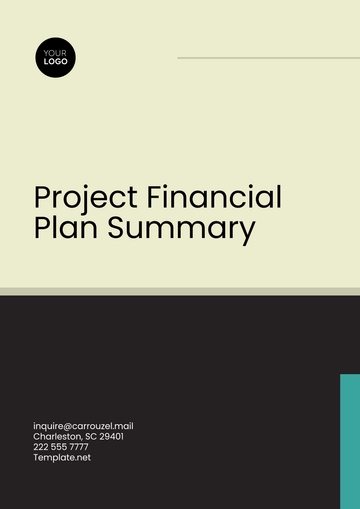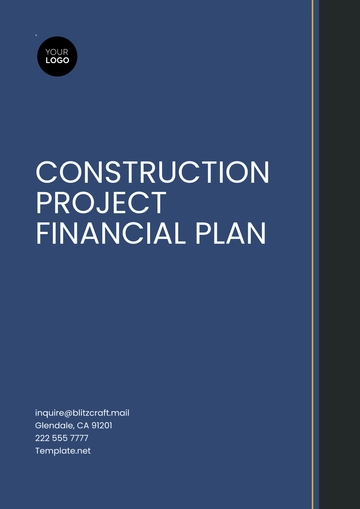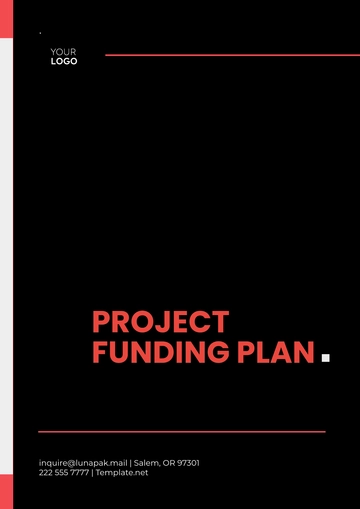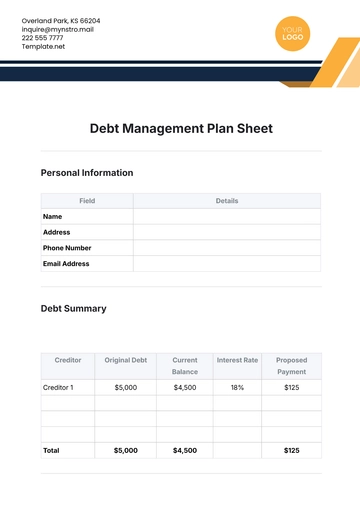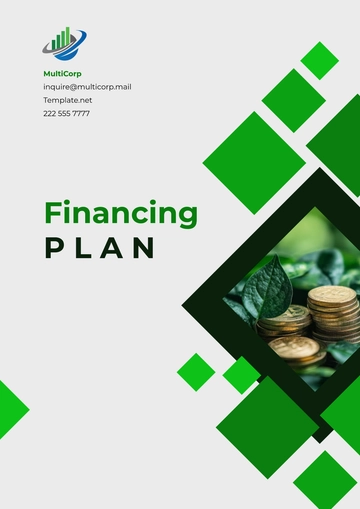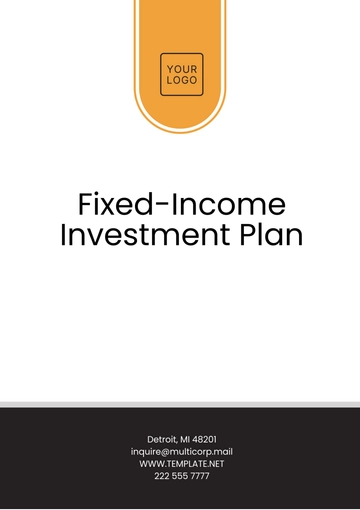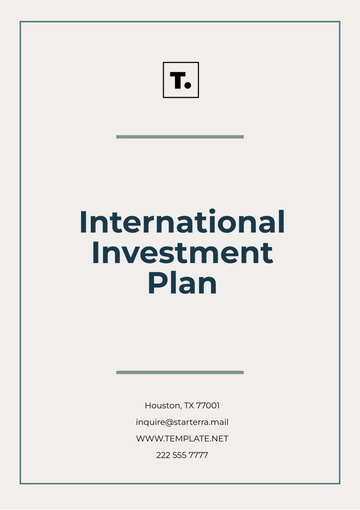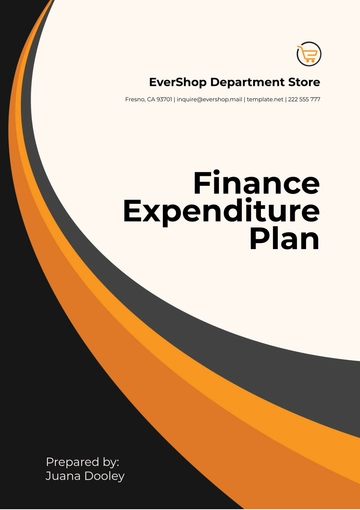Free Financial Cost Management Restructuring Plan
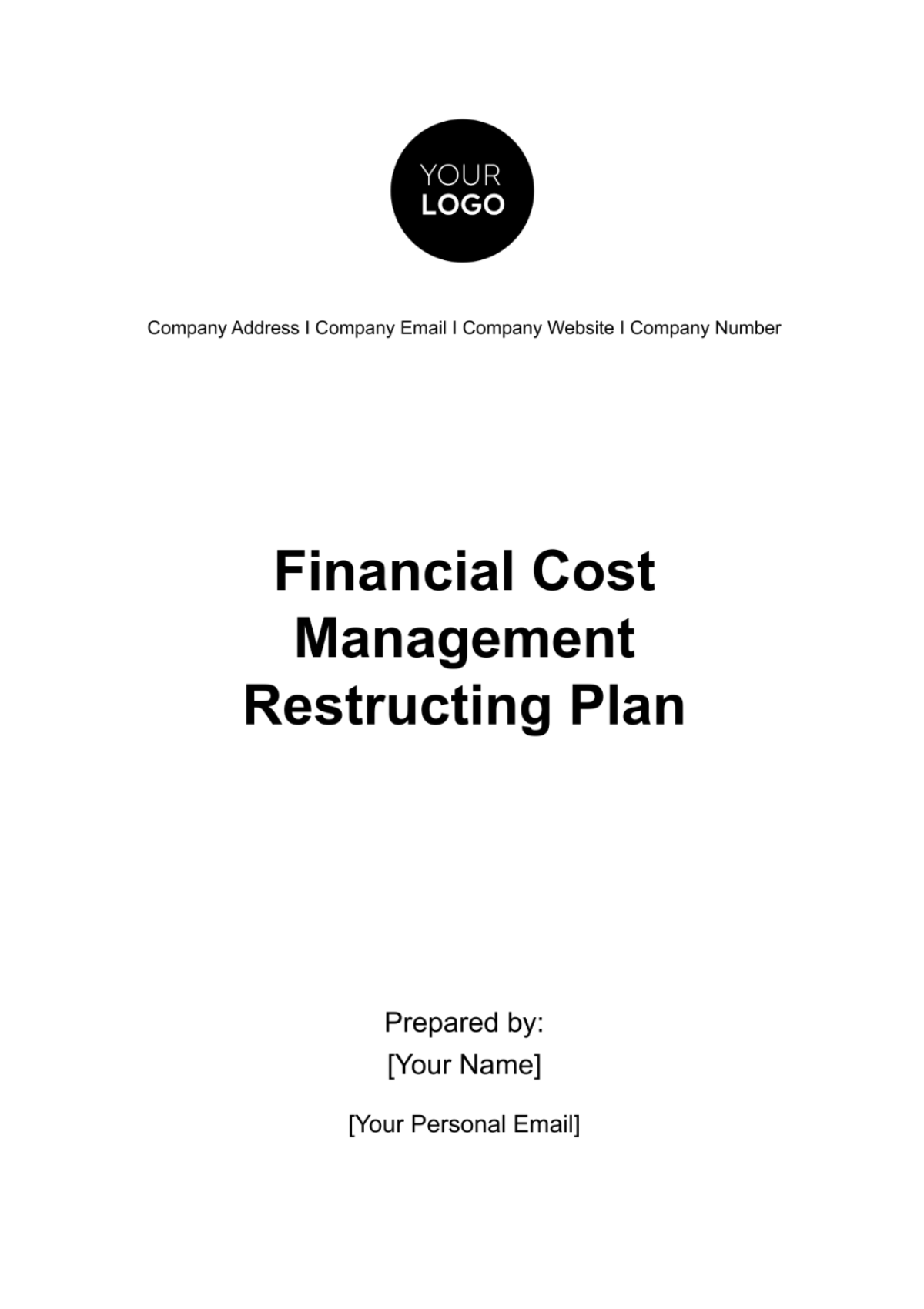
Executive Summary
As we navigate through a challenging financial landscape, our comprehensive Financial Cost Management Restructuring Plan is a strategic blueprint designed to stabilize and enhance our company's financial health. This plan is a result of an in-depth analysis of our current financial position and market dynamics, leading to a multifaceted approach encompassing cost reduction, revenue enhancement, debt restructuring, asset management, operational and human resource restructuring, and a robust monitoring and review process.
Key Components of the Plan:
Current Financial Analysis: Our financial statements reveal high levels of short-term and long-term debt, low profitability margins, and negative cash flow trends. This necessitates immediate and strategic interventions.
Cost Reduction Strategies: Targeted measures including workforce reduction, renegotiation of supplier contracts, and operational efficiency improvements are projected to save us approximately USD 90 million annually.
Revenue Enhancement Plans: Through new market penetration, product line expansion, and improved online sales platforms, we aim to increase our annual revenue by up to 15%, amounting to an additional USD 120 million.
Debt Restructuring Options: Restructuring proposals, including extending debt maturities and negotiating lower interest rates, are anticipated to reduce our annual interest expenses and improve our debt-to-equity ratio.
Asset Management and Divestiture: We plan to divest non-core assets, potentially raising USD 170 million, which will be utilized to reduce our overall debt burden.
Operational and HR Restructuring: By streamlining operations and optimizing our workforce, we expect to enhance efficiency and productivity, aligning human resources with our strategic goals.
Implementation Timeline and Milestones: Our restructuring plan is set to be implemented throughout 2084 and 2085, with key milestones outlined for effective monitoring and adaptation.
Financial Projections: Post-restructuring, we project a healthier balance sheet, improved income statements showing higher net income, and a positive cash flow trend. The break-even analysis indicates a lower threshold by mid-2084, with a projected ROI of 15% by the end of 2085.
Current Financial Analysis
In this section, we delve into a thorough analysis of our current financial status, as reflected in our balance sheet, income statement, and cash flow statement. This examination is critical to pinpoint the areas where financial stress and underperformance are most evident, guiding our strategies for improvement.
Balance Sheet Analysis
Assets | 2083 | Liabilities and Equity | 2083 | |
Cash and Cash Eq. | 50 | Accounts Payable | 120 | |
Accounts Receivable | 150 | Short-term Debt | 200 | |
Inventory | 100 | |||
Other Current Assets | 30 | Other Current Liabilities | 80 | |
Total Current Assets | 330 | Total Current Liabilities | 400 | |
Long-term Investments | 200 | Long-term Debt | 400 | |
PPE | 500 | |||
Intangible Assets | 100 | |||
Other Non-Current | 70 | Other Non-Current | 150 | |
Total Non-Current | 870 | Total Non-Current | 550 | |
Total Assets | 1,200 | Shareholder's Equity | 250 | |
Total Liabilities & Equity | 1,200 |
Our balance sheet reveals a high level of short-term debt (USD 200 million), which is exerting pressure on our liquidity. The substantial long-term debt (USD 400 million) also indicates a potential risk in our long-term financial stability. The asset base is solid with significant investments in Property, Plant & Equipment, and Long-term Investments, but the high level of liabilities compared to shareholder’s equity (Liabilities to Equity ratio of 3.8:1) is a concern.
Income Statement Analysis
Item | 2083 (USD in millions) |
Revenue | 800 |
Cost of Goods Sold (COGS) | 500 |
Gross Profit | 300 |
Operating Expenses | 200 |
Depreciation & Amortization | 50 |
Interest Expense | 40 |
Total Operating Expenses | 290 |
Operating Income | 10 |
Taxes | 3 |
Net Income | 7 |
The income statement shows a low operating income of USD 10 million on a revenue of USD 800 million, yielding a thin operating margin of 1.25%. The high Cost of Goods Sold (COGS) and operating expenses are significant contributors to this underperformance. Additionally, the interest expense (USD 40 million) is a considerable burden, reflecting the impact of our debt levels on profitability.
Cash Flow Statement Analysis
Item | 2083 (USD in millions) |
Net Income | 7 |
Depreciation & Amortization | 50 |
Changes in Working Capital | (20) |
Cash Flow from Operating Activities | 37 |
Capital Expenditures | (60) |
Investments | (30) |
Cash Flow from Investing Activities | (90) |
Debt Issuance | 100 |
Equity Issuance | 0 |
Debt Repayment | (50) |
Cash Flow from Financing Activities | 50 |
Net Change in Cash | (3) |
The cash flow statement reveals a concerning trend. Despite positive cash flow from operating activities (USD 37 million), our overall cash position has declined due to heavy capital expenditures and investments. The net change in cash is negative (USD -3 million), highlighting the need for a more balanced approach to capital management and investment strategies.
Key Areas of Financial Stress
Both short-term and long-term debts are putting pressure on our financial stability.
Margins are thin, indicating inefficiencies in operations and cost management.
Despite operational cash inflows, our cash reserves are depleting, driven by significant capital expenditures and investments.
Fluctuations in working capital suggest potential inefficiencies in managing receivables, payables, and inventory.
Addressing these areas will be pivotal in our restructuring plan to enhance our financial health and sustainability.
Cost Reduction Strategies
In response to the financial challenges identified in our analysis, we have developed a set of targeted cost-reduction strategies. These measures are designed to address key areas of inefficiency and financial stress, ultimately improving our overall financial performance.
Measure | Impact Analysis |
Reduction in Workforce | By reducing our workforce by 10%, we anticipate annual savings of approximately USD 20 million in labor costs. This measure, while difficult, is necessary to align our operational costs with current revenue levels. |
Renegotiation of Supplier Contracts | Renegotiating contracts with our top suppliers could reduce our COGS by 5%. This could result in cost savings of around USD 25 million annually, enhancing our gross profit margin. |
Consolidation of Operations | Consolidating our manufacturing facilities could save up to USD 15 million per year in operational costs. This includes reductions in rental, utilities, and maintenance expenses. |
Implementing Energy-Efficient Technologies | Investing in energy-efficient technologies is expected to reduce our energy costs by 20%, leading to annual savings of approximately USD 5 million. |
Streamlining Administrative Processes | By adopting more efficient administrative processes, we aim to cut administrative expenses by 15%, potentially saving up to USD 10 million annually. |
Reduction in Non-Essential Expenditure | Cutting non-essential expenses, such as travel, entertainment, and discretionary spending, could yield savings of about USD 5 million per year. |
Delaying Non-Critical Capital Expenditures | Postponing non-critical capital expenditures can improve our cash flow by USD 30 million in the short term, providing immediate relief to our financial position. |
Review Enhancement Plans
To complement our cost reduction strategies, we have formulated a series of revenue enhancement plans. These initiatives are designed to increase our revenue streams and improve our market positioning, ensuring long-term financial growth and sustainability.
Strategy | Expected Financial Impact |
New Market Penetration | By expanding into the Asian market, we project an increase in annual revenue by 15%, approximately USD 120 million. This expansion taps into emerging markets with high growth potential. |
Product Line Expansion | Introducing a new line of eco-friendly products is expected to boost revenue by 10%, equivalent to USD 80 million annually, by attracting environmentally conscious consumers and differentiating our brand. |
Enhanced Online Sales Platform | Upgrading our online sales platform to provide a more user-friendly and efficient shopping experience is anticipated to increase online sales revenue by 20%, around USD 30 million per year. |
Strategic Partnerships | Forming partnerships with complementary businesses could lead to a revenue increase of 5%, approximately USD 40 million annually, through cross-promotion and bundled offerings. |
Pricing Strategy Optimization | Adjusting our pricing strategy to better align with market demand and competitor pricing is expected to improve revenue by 8%, which translates to an increase of about USD 64 million. |
Loyalty and Retention Programs | Implementing customer loyalty and retention programs is projected to boost repeat business, potentially increasing annual revenue by 6%, roughly USD 48 million. |
Expanding into E-Commerce | Diversifying into e-commerce for wider product reach could lead to a 12% increase in revenue, approximately USD 96 million annually, by capturing a broader online customer base. |
Debt Restructuring Options
As part of our comprehensive restructuring plan, addressing our current debt structure is crucial for improving our financial health. A detailed analysis of our existing debt and potential restructuring options will allow us to reduce interest expenses and enhance cash flow, key steps towards achieving financial stability.
Analysis of Current Debt Structure
Our current debt structure, as evidenced in our balance sheet, comprises significant short-term and long-term liabilities totaling USD 600 million. The short-term debt, standing at USD 200 million, poses immediate liquidity challenges, while the long-term debt of USD 400 million impacts our long-term financial sustainability. The associated interest expenses, as seen in our income statement, amount to USD 40 million annually, which is a considerable strain on our profitability. The high leverage ratio (debt to equity of 2.4:1) indicates an elevated financial risk and necessitates immediate attention to improve our debt profile and reduce interest burden.
Options for Debt Refinancing or Restructuring
Option | Impact Analysis |
Extending Maturity of Short-term Debt | Converting USD 100 million of short-term debt into long-term debt can reduce immediate liquidity pressure and improve our working capital position. This would extend the payment horizon and ease cash flow constraints. |
Negotiating Lower Interest Rates | Renegotiating interest rates could potentially reduce our annual interest expenses by 20%, leading to savings of approximately USD 8 million per year. This would enhance our net income and cash flow. |
Debt for Equity Swap | Converting USD 150 million of debt into equity could significantly lower our debt burden and improve our debt-to-equity ratio, enhancing financial stability and potentially improving investor confidence. |
Securing a Revolving Credit Facility | Establishing a revolving credit facility of USD 50 million would provide flexible access to capital, helping to manage cash flow more effectively during times of financial strain. |
Asset Management and Divestiture
In our pursuit of financial restructuring, effective asset management and strategic divestiture play a pivotal role. We are thoroughly evaluating our current assets to determine their contribution to our business and considering the sale of non-core assets to reduce our debt and refocus on our primary areas of operation.
Review of Current Assets
Our current asset portfolio, as detailed in our balance sheet, includes a variety of holdings such as long-term investments, property, plant & equipment, and intangible assets, totaling USD 870 million. The long-term investments, valued at USD 200 million, are a mix of equity and debt instruments, some of which are not directly contributing to our core business operations. The property, plant, and equipment assets, which amount to USD 500 million, are central to our manufacturing capabilities, but they also include facilities that are underutilized or not aligned with our strategic focus. The intangible assets, worth USD 100 million, primarily consist of intellectual property and goodwill, some of which are remnants of past acquisitions and may no longer be essential to our core business strategy.
Consideration of Selling Non-Core Assets
To strengthen our financial position and streamline our operations, we are considering the following divestiture options:
Sale of Select Long-term Investments: By divesting a portion of our long-term investments that are not yielding significant returns or are unrelated to our core business, we could potentially raise up to USD 50 million. This capital could be directly applied to debt reduction.
Disposal of Underutilized Properties and Equipment: We have identified certain properties and pieces of equipment that are not fully utilized or do not align with our strategic direction. The sale of these assets could generate approximately USD 75 million, contributing to our efforts to decrease overall debt levels.
Divestiture of Non-Essential Intangible Assets: Certain intangible assets, such as patents or trademarks from previous acquisitions that are no longer vital to our business, could be sold. This could yield an estimated USD 30 million, further aiding in our debt reduction efforts.
Liquidation of Redundant Inventory: Streamlining our inventory to focus on high-demand products could release tied-up capital, estimated at around USD 15 million, which can be used for debt servicing or reinvestment in core business areas.
Operational Restructuring
To enhance our financial resilience and competitive edge, operational restructuring is imperative. We are focusing on revamping our operational procedures and integrating new technologies to boost efficiency and reduce operational costs.
Changes to Operational Procedures
Streamlining Production Processes: By adopting lean manufacturing principles, we aim to reduce waste and enhance production efficiency. This includes optimizing production layouts and workflows, which could lead to a 10% reduction in manufacturing costs.
Supply Chain Optimization: Restructuring our supply chain by consolidating suppliers and renegotiating terms can lead to more cost-effective procurement and inventory management, potentially saving up to 8% in supply chain costs.
Energy Efficiency Programs: Implementing energy-saving measures in our facilities, like LED lighting and energy-efficient machinery, is expected to reduce energy costs by approximately 15%.
Adoption of Automation and Robotics: Integrating automation in certain production areas could improve output consistency and reduce labor costs by up to 12%.
Implementation of New Technologies
Upgrading to Cloud Computing: Transitioning to cloud-based systems for data management and operations can reduce IT infrastructure costs by 20%.
Implementing Advanced Analytics: Utilizing data analytics tools to optimize inventory levels, production schedules, and customer demand forecasting can lead to a more efficient operation, potentially cutting related costs by 10%.
Investment in Sustainable Technologies: Embracing green technologies not only aligns with environmental goals but also reduces long-term operational costs through tax incentives and lower energy consumption.
Process Automation Software: Implementing process automation in administrative and back-office functions can reduce associated costs by approximately 15%.
Human Resource Restructuring
Our workforce is our most valuable asset, and in these challenging times, strategic human resource restructuring is essential. We are committed to reshaping our workforce in a way that preserves talent while aligning with our more streamlined and efficient organizational structure.
Potential Changes in Staffing Levels
Reduction in Non-Critical Roles: As previously mentioned, a 10% reduction in workforce, particularly in areas that are overstaffed or non-critical, is planned. This will result in a leaner, more focused team.
Restructuring of Departments: Consolidating departments with overlapping functions to eliminate redundancies and improve coordination. This includes merging certain administrative and support roles.
Plans for Retraining or Redeploying Employees
Retraining Programs: Implementing retraining programs to upskill employees, enabling them to take on more technically advanced or diversified roles within the company.
Internal Mobility Initiatives: Encouraging internal mobility to allow employees to transition into roles that are more critical to our new strategic direction, thus retaining institutional knowledge and talent.
Performance Management and Development: Strengthening our performance management processes to focus on employee development, aligning individual goals with our organizational objectives.
Support for Affected Employees: Providing support for employees impacted by the restructuring, including career counseling, job search assistance, and potential severance packages.
Risk Management and Assessment
In implementing our restructuring plan, it is vital to recognize and manage potential risks effectively. This section outlines the key risks associated with our plan and the strategies we have devised to mitigate them.
Risk | Mitigation Strategy |
Employee Morale and Productivity Loss | Implement comprehensive communication strategies and support programs to maintain morale and engagement during transitions. |
Disruption to Operations During Changes | Develop a phased implementation plan with contingencies to minimize operational disruptions. |
Customer Retention and Brand Image Risk | Engage in proactive customer communication and branding strategies to reinforce our commitment to quality and reliability. |
Misalignment of Restructured Operations with Market | Conduct ongoing market analysis and maintain flexibility in operations to adapt to market changes. |
Higher-than-Anticipated Restructuring Costs | Establish a detailed budget with a contingency allowance for unexpected costs, and conduct regular financial reviews. |
Ineffective Implementation of New Technologies | Partner with technology experts for implementation and provide comprehensive training to employees. |
Regulatory Compliance Risks | Ensure compliance with all regulatory requirements, updating policies and procedures as needed. |
Implementation Timeline
Effective execution of our restructuring plan requires a clear timeline and set milestones. This section provides a detailed schedule for the implementation of our plan, along with key performance indicators to monitor progress.
Phase | Timeline | Key Milestones and KPI |
Initial Planning and Strategy Formation | Q1 2084 | Completion of restructuring strategy, approval from Board of Directors |
Communication and Employee Engagement | Q1-Q2 2084 | All staff briefed, initiation of support and training programs |
Operational and HR Restructuring | Q2-Q3 2084 | Implementation of new operational procedures, completion of workforce restructuring |
Financial Restructuring | Q2-Q4 2084 | Successful renegotiation of debt terms, initiation of asset divestiture |
Revenue Enhancement Initiatives | Q3 2084-Q1 2085 | Launch of new market penetration and product line expansion, online platform upgrade |
Ongoing Review and Adjustments | Starting Q4 2084 | Regular performance reviews, adjustments based on KPIs such as cost savings and revenue |
Long-term Strategy Implementation | Q1 2085 onwards | Continued execution of long-term growth and efficiency strategies |
Financial Projections
As we embark on our restructuring journey, it is crucial to forecast the financial outcomes of our efforts. This section presents projected financial statements post-restructuring, providing insights into our expected financial position, along with a break-even analysis and return on investment projections.
Projected Balance Sheet (Post-Restructuring)
Assets | 2084 (USD in millions) | 2085 (USD in millions) |
Cash and Cash Equivalents | 70 | 100 |
Accounts Receivable | 140 | 130 |
Inventory | 90 | 80 |
Total Current Assets | 325 | 330 |
Long-term Investments | 150 | 140 |
Property, Plant & Equipment | 450 | 430 |
Intangible Assets | 90 | 80 |
Total Non-Current Assets | 750 | 700 |
Total Assets | 1,075 | 1,030 |
Liabilities and Equity | 2084 (USD in millions) | 2085 (USD in millions) |
Accounts Payable | 110 | 100 |
Short-term Debt | 150 | 100 |
Total Current Liabilities | 330 | 260 |
Long-term Debt | 350 | 300 |
Other Non-Current Liabilities | 130 | 120 |
Total Non-Current Liabilities | 480 | 420 |
Shareholder's Equity | 265 | 350 |
Total Liabilities & Equity | 1,075 | 1,030 |
Projected Income Statement (Post-Restructuring)
Item | 2084 (USD in millions) | 2085 (USD in millions) |
Revenue | 880 | 950 |
Cost of Goods Sold (COGS) | 450 | 430 |
Gross Profit | 430 | 520 |
Operating Expenses | 180 | 170 |
Depreciation & Amortization | 40 | 35 |
Interest Expense | 30 | 25 |
Total Operating Expenses | 250 | 230 |
Operating Income | 180 | 290 |
Taxes | 45 | 72 |
Net Income | 135 | 218 |
Projected Cash Flow Statement (Post-Restructuring)
Item | 2084 (USD in millions) | 2085 (USD in millions) |
Depreciation & Amortization | 40 | 35 |
Changes in Working Capital | (15) | (10) |
Cash Flow from Operating Activities | 160 | 243 |
Capital Expenditures | (30) | (25) |
Investments | (20) | (15) |
Cash Flow from Investing Activities | (50) | (40) |
Debt Issuance | 0 | 0 |
Equity Issuance | 50 | 0 |
Debt Repayment | (50) | (50) |
Cash Flow from Financing Activities | 0 | (50) |
Net Change in Cash | 110 | 153 |
Break-even Analysis and ROI Projections
With the projected increase in revenue and reduction in costs, our break-even point is expected to lower significantly by 2085. We anticipate reaching this point by mid-2084, earlier than in previous years.
The ROI from our restructuring initiatives, considering cost savings and revenue enhancements, is projected to be around 15% by the end of 2085. This takes into account the initial investments in technology, workforce restructuring, and debt restructuring costs.
Stakeholder Communication Plan
Effective communication is essential to ensure the successful implementation of our restructuring plan, as it significantly impacts various stakeholders. This section outlines our strategy for transparently communicating the changes and managing the expectations and responses of our key stakeholders: employees, investors, creditors, and customers.
Stakeholder | Strategy | Managing Expectations and Responses |
Employees | Regular internal briefings, town hall meetings, and updates through internal channels. | Clearly explaining the reasons for restructuring, the expected impact on roles, and the support available to affected employees. Addressing concerns promptly. |
Investors | Detailed presentations on restructuring plans during shareholder meetings, updates through annual reports. | Emphasizing the long-term benefits and financial health improvements expected from the restructuring. Responding to inquiries and concerns effectively. |
Creditors | Formal notifications and one-on-one meetings to discuss debt restructuring and payment plans. | Ensuring transparency about our financial situation and plans for debt repayment. Building trust through consistent communication. |
Customers | Communication through press releases, website updates, and direct outreach to key clients. | Reassuring customers about continued service quality and reliability during restructuring. Addressing any concerns about product or service delivery. |
Monitoring and Review Process
An effective monitoring and review process is key to the success of our restructuring plan. This ongoing process will ensure that we stay on track with our implementation and make necessary adjustments in response to performance outcomes and changing conditions.
Monitoring Activity | Frequency | Approach |
Financial Performance Reviews | Quarterly | Analyzing financial statements against projections, making adjustments in cost management and revenue strategies. |
Operational Efficiency Assessments | Bi-annually | Reviewing operational metrics, adjusting processes and technologies to improve efficiency. |
Human Resource Impact Analysis | Annually | Evaluating the impact of HR restructuring on productivity and morale, making changes in workforce management as needed. |
Debt and Asset Management Reviews | Bi-annually | Assessing the progress of debt restructuring and asset divestitures, making necessary financial adjustments. |
Stakeholder Feedback Surveys | Annually | Collecting feedback from employees, investors, creditors, and customers to inform adjustments in communication and strategy. |
- 100% Customizable, free editor
- Access 1 Million+ Templates, photo’s & graphics
- Download or share as a template
- Click and replace photos, graphics, text, backgrounds
- Resize, crop, AI write & more
- Access advanced editor
Financial Cost Management Restructuring Plan Template from Template.net offers a strategic approach to revamping financial operations. Editable and customizable in our AI tool, this template is perfect for outlining detailed restructuring plans, focusing on cost management. It aids in developing clear, actionable strategies, essential for businesses seeking to optimize financial performance and enhance cost efficiency.
You may also like
- Finance Plan
- Construction Plan
- Sales Plan
- Development Plan
- Career Plan
- Budget Plan
- HR Plan
- Education Plan
- Transition Plan
- Work Plan
- Training Plan
- Communication Plan
- Operation Plan
- Health And Safety Plan
- Strategy Plan
- Professional Development Plan
- Advertising Plan
- Risk Management Plan
- Restaurant Plan
- School Plan
- Nursing Home Patient Care Plan
- Nursing Care Plan
- Plan Event
- Startup Plan
- Social Media Plan
- Staffing Plan
- Annual Plan
- Content Plan
- Payment Plan
- Implementation Plan
- Hotel Plan
- Workout Plan
- Accounting Plan
- Campaign Plan
- Essay Plan
- 30 60 90 Day Plan
- Research Plan
- Recruitment Plan
- 90 Day Plan
- Quarterly Plan
- Emergency Plan
- 5 Year Plan
- Gym Plan
- Personal Plan
- IT and Software Plan
- Treatment Plan
- Real Estate Plan
- Law Firm Plan
- Healthcare Plan
- Improvement Plan
- Media Plan
- 5 Year Business Plan
- Learning Plan
- Marketing Campaign Plan
- Travel Agency Plan
- Cleaning Services Plan
- Interior Design Plan
- Performance Plan
- PR Plan
- Birth Plan
- Life Plan
- SEO Plan
- Disaster Recovery Plan
- Continuity Plan
- Launch Plan
- Legal Plan
- Behavior Plan
- Performance Improvement Plan
- Salon Plan
- Security Plan
- Security Management Plan
- Employee Development Plan
- Quality Plan
- Service Improvement Plan
- Growth Plan
- Incident Response Plan
- Basketball Plan
- Emergency Action Plan
- Product Launch Plan
- Spa Plan
- Employee Training Plan
- Data Analysis Plan
- Employee Action Plan
- Territory Plan
- Audit Plan
- Classroom Plan
- Activity Plan
- Parenting Plan
- Care Plan
- Project Execution Plan
- Exercise Plan
- Internship Plan
- Software Development Plan
- Continuous Improvement Plan
- Leave Plan
- 90 Day Sales Plan
- Advertising Agency Plan
- Employee Transition Plan
- Smart Action Plan
- Workplace Safety Plan
- Behavior Change Plan
- Contingency Plan
- Continuity of Operations Plan
- Health Plan
- Quality Control Plan
- Self Plan
- Sports Development Plan
- Change Management Plan
- Ecommerce Plan
- Personal Financial Plan
- Process Improvement Plan
- 30-60-90 Day Sales Plan
- Crisis Management Plan
- Engagement Plan
- Execution Plan
- Pandemic Plan
- Quality Assurance Plan
- Service Continuity Plan
- Agile Project Plan
- Fundraising Plan
- Job Transition Plan
- Asset Maintenance Plan
- Maintenance Plan
- Software Test Plan
- Staff Training and Development Plan
- 3 Year Plan
- Brand Activation Plan
- Release Plan
- Resource Plan
- Risk Mitigation Plan
- Teacher Plan
- 30 60 90 Day Plan for New Manager
- Food Safety Plan
- Food Truck Plan
- Hiring Plan
- Quality Management Plan
- Wellness Plan
- Behavior Intervention Plan
- Bonus Plan
- Investment Plan
- Maternity Leave Plan
- Pandemic Response Plan
- Succession Planning
- Coaching Plan
- Configuration Management Plan
- Remote Work Plan
- Self Care Plan
- Teaching Plan
- 100-Day Plan
- HACCP Plan
- Student Plan
- Sustainability Plan
- 30 60 90 Day Plan for Interview
- Access Plan
- Site Specific Safety Plan

